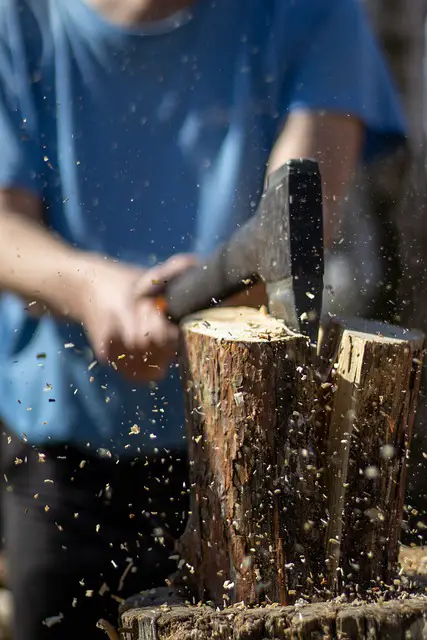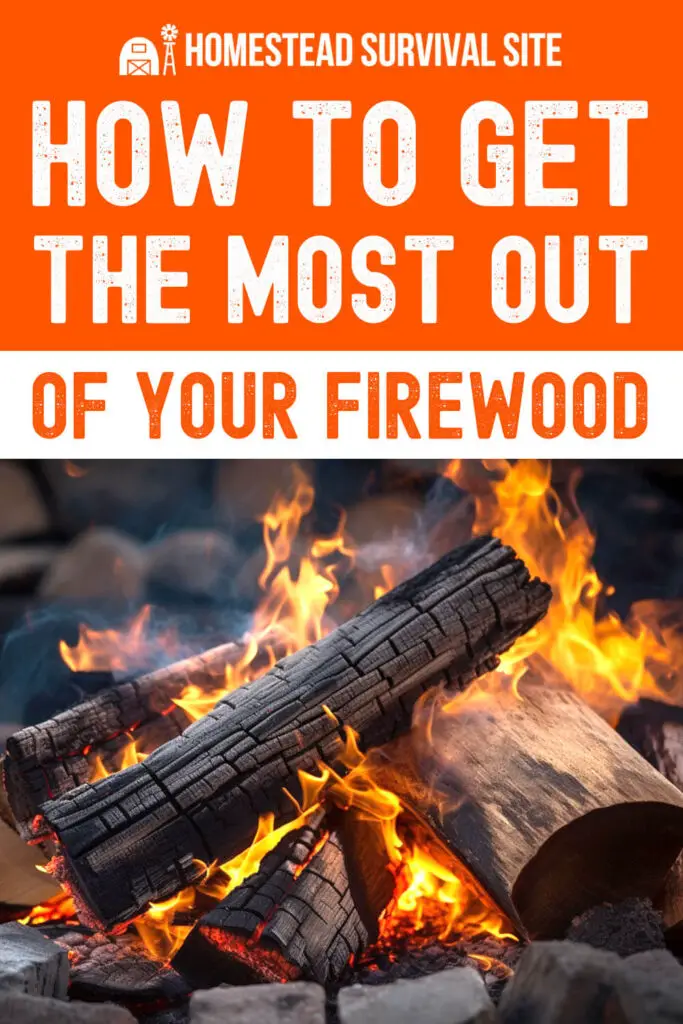Estimated reading time: 8 minutes
Maximizing the use of your firewood is not only practical for keeping you warm but also in managing this precious resource so you always have it. This article will guide you on how to efficiently harness the heat from your firewood.
You'll learn about the best types of wood for burning, techniques for splitting and storing firewood, and handy tips for getting more warmth from your firewood.
Want to save this post for later? Click Here to Pin It On Pinterest!
Decoding the Science of Heat Values in Firewood
Your search begins by understanding that different types of wood give off differing amounts of heat.
The heat value of firewood, often measured in British Thermal Units (BTUs), describes the energy content within a given volume of wood. This measurement matters significantly in firewood usage, as it influences how much heat your firewood can provide.
For instance, let's examine two common types of wood: spruce and oak. Spruce, a softwood, has a heat value of roughly between 14 to 19 million BTUs per cord. While it lights up quickly and burns fast, it doesn't provide sustained heat over long periods.
On the other hand, oak, a hardwood, packs a punch with an average heat value of approximately 24 to 29 million BTUs per cord. It burns slowly and steadily, providing a reliable source of heat over an extended period. In terms of BTU, oak surpasses spruce and is a more efficient choice for long-lasting warmth.
Woods with higher heat values yield more heat, making them more efficient for warming your home. For example, hardwoods like hickory typically have high BTUs, meaning they release a greater amount of heat.
Lower BTU woods, while still usable, burn less efficiently than their high BTU counterparts. This inefficient combustion often results in the production of creosote, a flammable byproduct that can build up in your chimney, increasing the risk of chimney fires and necessitating regular cleanings.
The Best and the Worst Firewood

When choosing firewood, it's essential to consider its heat value for efficient burning. Here are some common types of wood and how they fare as firewood:
- Oak: Known for its high heat output, Oak is considered one of the best firewood types. It burns slowly and evenly, producing long-lasting heat.
- Hickory: Similar to Oak, Hickory has high heat values and is very efficient as firewood. It's dense and burns for a long time, providing sustained warmth.
- Pine: While Pine is easy to light and burns brightly, its heat value is lower than hardwoods like Oak and Hickory. It's best used for kindling or mixed with other woods for a sustained fire.
- Poplar: Poplar has a low heat value compared to other hardwoods. It burns quickly and doesn't provide as much heat, making it less ideal for heating purposes.
- Birch: Birch offers a moderate heat value. It burns faster than Oak or Hickory, but slower than Pine or Poplar. It's a good choice if other hardwoods are unavailable.
During the winter months, your best bet for firewood would be oak or hickory. These hardwoods have high heat values, meaning they burn slowly and provide sustained warmth, perfect for those long, cold winter nights.
The Art of Splitting Firewood
Splitting firewood is a crucial step in the preparation process. This helps the wood to dry or ‘season' evenly and more quickly, as the split exposes more surface area to the air. When firewood is split and properly seasoned, it produces more heat, burns cleaner, and is easier to ignite. Additionally, split wood is more manageable and safer to burn in most fireplaces or stoves due to its uniform size.
How to Split Firewood

With consistent practice, the act of splitting firewood becomes second nature, allowing you to develop muscle memory. Over time, your accuracy will significantly improve, enabling you to split logs more efficiently and safely.
- Choose the Right Tools: For splitting firewood, you'll need a splitting maul or axe and safety gear like gloves and eye protection.
- Place the Log: Position your log upright on a sturdy and level surface. A tree stump or splitting block is ideal.
- Take Position: Stand in a comfortable stance, feet shoulder-width apart for balance. Hold the axe with both hands – one at the top of the handle and the other near the base.
- Aim and Swing: Aim for a spot near the edge of the log, not the center. Swing the axe in a downward arc. Use your body weight and a smooth, controlled motion rather than relying purely on arm strength.
- Split Through: Ideally, the log will split in one go. If not, remove the axe and repeat. Once the log splits, use the same process for each piece until it's the right size for your stove or fireplace.
The idea is to not hit any part of your body, especially your legs.You can do some serious damage with a full power swing that misses the wood.
Safety Precautions While Splitting Wood
While splitting firewood, safety should always be your top priority. Here are some tips to help mitigate injury :
- Wear Protective Gear: Always use safety glasses to protect your eyes from flying debris, and gloves to cushion your hands and improve grip. Wear heavy-duty or steel-toed shoes to protect your feet.
- Clear your Surroundings: Ensure the area around you is clear of people, pets, and obstacles to avoid accidents.
- Check your Tools: Inspect your splitting maul or axe for damage before each use. A loose or damaged head can be hazardous.
- Mind your Posture and Positioning: Maintain a stable footing and avoid overreaching or twisty movements that could strain your back or make you lose balance.
- Take Breaks: Don't rush the process. Take regular breaks to avoid fatigue which can lead to loss of concentration.
- Stay Hydrated: Especially if you're splitting wood in warm weather, make sure you're drinking enough water to stay hydrated.
Having a small medical kit on hand while splitting firewood is a wise precaution. In the event of an accident, immediate access to basic medical supplies like bandages, antiseptics, and pain relief can make a significant difference, helping to treat wounds promptly and prevent further complications.
Storing Firewood Effectively

Storing firewood properly is paramount to maintaining its quality and heat output. It ensures the wood is dry, preventing the growth of mold and insects which can decrease its heating efficiency. When stored properly, firewood can last for years, ready to provide warmth whenever needed.
Here are some essential tips for storing firewood effectively:
- Keep the Firewood Dry: Protect your firewood from moisture to prevent it from rotting or becoming infested with insects. Use a firewood cover or store it under a shed to shield it from rain or snow.
- Elevate the Wood: Keep the firewood off the ground to avoid it absorbing water or becoming a breeding ground for pests. Use a firewood rack, pallet, or a custom-built storage solution.
- Cover the Top, but Not the Sides: While it's crucial to keep the top of your firewood pile covered to protect it from precipitation, the sides should be left open to allow for proper airflow, which aids in the drying process.
- Stack the Wood Properly: Stack your firewood in a way that allows air to circulate. Crisscrossing the logs or leaving spaces between them can help. It prevents pests from moving in and water to start rotting away the wood.
- Store in a Convenient Location: Place your firewood storage close to your home but not directly against it, to prevent pests from invading your house.
Ideally, firewood should be stored in late winter to early spring, giving it sufficient time to dry out before the next heating season. Most people will have a year's supply of firewood done in advance so that there is always readily available wood.
Efficient Use of Firewood
Maximizing the use of firewood involves understanding how to control your fire. Keep the fire small and intense rather than large and slow, as a smaller fire generates less smoke and more heat. Using a wood stove can greatly improve efficiency. Modern wood stoves burn wood more completely, reducing smoke and getting the most heat from your firewood.
Using firewood efficiently involves burning seasoned wood, using smaller logs, burning them hot and fast, and regularly maintaining your wood stove or fireplace. These practices reduce creosote buildup, reduce smoke, and utilize the maximum amount of heat.
Avoid using punky or rotting wood as the moisture locked inside will smolder instead of producing high heat. If possible, sit the wet or punky logs by the fire to start drying them out.
The environmental impact of burning wood can be significant, but it can be minimized. Burning dry, seasoned wood and using a modern, efficient wood stove can greatly reduce smoke and particulate emissions.
Additionally, replanting trees to replace those used for firewood can help offset the carbon emissions from burning wood. Always source your firewood locally to reduce the spread of pests and diseases.
Conclusion
The key takeaways include seasoning wood, using smaller logs, burning them hot and fast, and maintaining your wood stove or fireplace. Avoiding wet or rotting wood and responsibly sourcing local firewood also play significant roles.
It's advisable to familiarize yourself with the types of wood in your local area, to understand which burns best. Every region is different, and the best firewood for you might be right in your backyard.
Like this post? Don't Forget to Pin It On Pinterest!
You May Also Like:











For the most efficient burn and heat capture, a rocket mass heater, either a j tube or batch box is hard to beat as the fire burns intensely at very high temperatures, burning most of the smoke, and capturing most of the heat in the thermal mass, much like the masonry heaters do. Either of these will maximize your heat that is released over time unlike the metal stoves that put out a lot of heat in a short period of time with the majority of the heat going up the chimney.
I’m 75 and have been burning wood for most of those years. This article was obviously written by a city slicker whose only experience with firewood is striking a wood match to light the grill.
RatM… As an experienced and knowledgeable person in this area, what additional information would you offer to expand or improve what was included in this article?
You said it. 👍